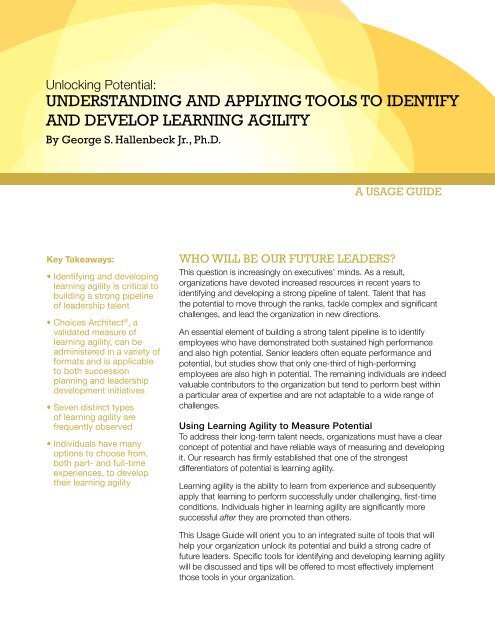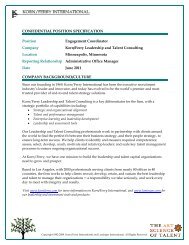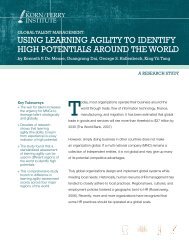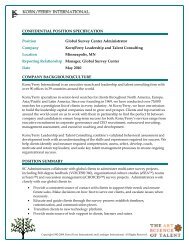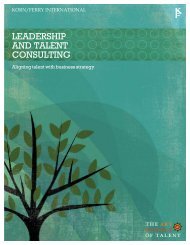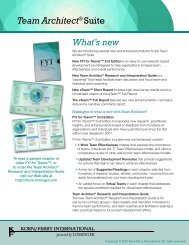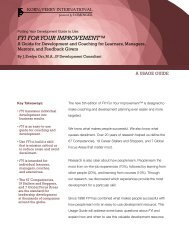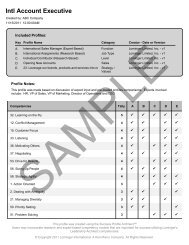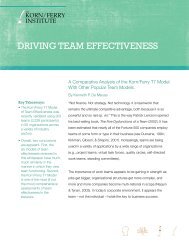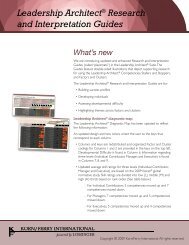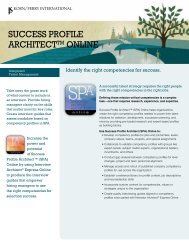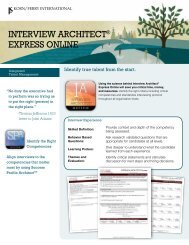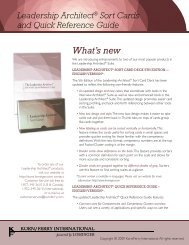understanding and applying tools to identiFy and ... - Lominger
understanding and applying tools to identiFy and ... - Lominger
understanding and applying tools to identiFy and ... - Lominger
You also want an ePaper? Increase the reach of your titles
YUMPU automatically turns print PDFs into web optimized ePapers that Google loves.
Recent research has shown that rating patterns for learning agility arequite consistent across different global regions, supporting our view thatlearning agility is a quality that is normally distributed throughout thepopulation <strong>and</strong> doesn’t differ along lines such as age, gender, or levelin the organization. Learning agility, it seems, can be found just aboutanywhere.To support your organization’s efforts <strong>to</strong> search broadly for learningagility, we have recently exp<strong>and</strong>ed the number of languages in which thesurvey is available. The current list includes Spanish, French, German,Italian, Brazilian Portuguese, Simplified Chinese, <strong>and</strong> Japanese.The survey is delivered <strong>to</strong> all raters in the same format (81 r<strong>and</strong>omizeditems) <strong>and</strong> takes about 15–20 minutes <strong>to</strong> complete. E-mail invitations<strong>to</strong> raters can be cus<strong>to</strong>mized <strong>to</strong> inform them about the organization’spurpose for conducting the survey <strong>and</strong> <strong>to</strong> provide specific instructions.Recent research has shownthat rating patterns forlearning agility are quiteconsistent across differentglobal regions...The Global Survey Center will work with you <strong>to</strong>:• Confirm rater assignments.• Provide status completion reports.• Issue reminders <strong>and</strong> process reports in a timely manner.Reports come in a choice of two basic formats: a “short report,”commonly used for succession planning purposes <strong>and</strong> a “long report,”typically used for development purposes.The eChoices Online Survey “Short Report” Format. Thisreport provides the necessary information that talent managers <strong>and</strong>organizational leaders need <strong>to</strong> assess whether an individual meets thecriteria for having high levels of learning agility <strong>and</strong> should be designatedas having high potential. The report highlights an individual’s overalllearning agility score <strong>and</strong> how it ranks compared <strong>to</strong> our norms <strong>and</strong> alsoprovides scores on the four learning agility fac<strong>to</strong>rs <strong>and</strong> 27 dimensions.The raters for the short report are generally the individuals directlyinvolved in <strong>and</strong> responsible for making talent decisions for theorganization or a particular business unit. Raters typically include theindividual’s boss, the boss’s boss, <strong>and</strong> someone in a senior talentmanagement role. The individual being rated is typically not includedas a self-rater <strong>and</strong> in some instances may be unaware that he or she isbeing rated.3
Sample Participant 9/26/08Fac<strong>to</strong>r SummaryCHOICES® ARCHITECTMulti-Rater ReportRANKNot At All LikeThisLess Often ThanMostAbout Like MostPeopleBetter / MoreOften Than MostFACTORS MEAN 1 2 3 4 5The ClearestExample of ThisUnratedItems<strong>Lominger</strong>NormAverageNormPercentile1.0 Fac<strong>to</strong>r IV: Results Agility 4.252% 3.50 902.0 Fac<strong>to</strong>r I: Mental Agility 3.875% 3.33 84-863.0 Fac<strong>to</strong>r III: Change Agility 3.855% 3.33 78-814.0 Fac<strong>to</strong>r II: People Agility 3.792% 3.36 81Excluding self as a rater is strongly recommended for two reasons:1. Our best practices support keeping the succession planningprocess a private one, at least until the organization hasestablished a highly refined <strong>and</strong> successful talent review process.Transparency, while well-intentioned, can lead <strong>to</strong> difficulties,particularly when individuals feel excluded or passed over.The long report format isideal when the organizationwants <strong>to</strong> rate someone’slearning agility purely fordevelopmental purposes.2. Research consistently shows that individuals are not effective atrating themselves on Choices Architect ® — individuals rated lowby others typically overrate themselves, while the opposite istrue of individuals rated high by others in learning agility. Thesediscrepancies can lead <strong>to</strong> awkwardness, even conflict, especiallywhen individuals perceive their learning agility <strong>to</strong> be much higherthan others see it.© Copyright 2007 LOMINGER INTERNATIONAL: A KORN/FERRY COMPANY. All Rights Reserved.Page 11 of 57The eChoices Online Survey “Long Report” Format. The longreport format is ideal when the organization wants <strong>to</strong> rate someone’slearning agility purely for developmental purposes. This may occur at thepoint where someone has already been confirmed by the organizationas a high potential or when the individual is working in a role that has ahigh dem<strong>and</strong> for learning agility in order <strong>to</strong> be successful.Rater selection for the long report differs from the short report. Typically,the rater list is exp<strong>and</strong>ed <strong>to</strong> include not only the boss <strong>and</strong> other seniorlevelraters, but also peers <strong>and</strong> direct reports. In this case, the individual4
eing rated is usually involved as a self-rater. The combination ofmultiple, diverse raters <strong>and</strong> comparison between self <strong>and</strong> other ratingsgives the individual an experience more typical of a 360° feedbacksurvey <strong>and</strong> facilitates awareness <strong>and</strong> development.Sample Participant 9/26/08Group SummaryCHOICES ARCHITECT®Multi-Rater ReportH = among the 1/3 highestL = among the 1/3 lowestRANKRATING ITEM GROUP RANGE MEAN 1 2 3 4 5Not At All LikeThisLess Often ThanMostAbout Like MostPeopleBetter / MoreOften Than MostThe ClearestExample of ThisGAPINDICATORH/LSelf 3-54.50H1.0 Fac<strong>to</strong>r IV: Results AgilityAll Others 2-5 4.25-0.25 HDirect Manager(s) 3-5 4.42-0.08Other Manager(s) 2-5 3.63-0.87Peers 3-5 4.540.04Direct Reports 3-5 4.38-0.12HHHHSelf 3-43.33L10.0 Dimension 24: Inspires Others3.98All Others 2-5 0.65(Results Agility)4.00Direct Manager(s) 3-5 0.67Other Manager(s) 2-4 3.00-0.33Peers 4-5 4.671.34LHDirect Reports 3-4 3.830.50The eChoices Online Survey long report includes the same content asSelf 3-3 3.00Lthe short report, plus two additional sections:13.0 24. Can inspire a team <strong>to</strong> work hard.All Others 3-5 4.171.17 HDirect Manager(s) 5-5 5.002.00 H• An item report that features Other Manager(s) a rank-ordered 3-3 3.00 list of scores on each0.00 LPeers 4-5 4.501.50of the 81 survey items.Direct Reports 4-4 4.001.00• A summary report that provides a breakdown of ratings from eachrating group for every item, dimension, <strong>and</strong> fac<strong>to</strong>r <strong>and</strong> highlightsSelf 4-4 4.00self-other rating differences.10.5 51. Can state his/her case orAll Others 4-5 4.290.29 Hviewpoint with energizingDirect Manager(s) 4-4 4.000.00passion.Choices Architect ® 4.00Quick Score Questionnaire –5.00Ideal When You Need Instant Scoring4.00Other Manager(s) 4-4 0.00Peers 5-5 1.00Direct Reports 4-4 0.00The Quick Score format provides a paper-based alternative <strong>to</strong> theelectronic survey <strong>and</strong> is ideal when a limited number of surveys are© Copyright 2007 LOMINGER INTERNATIONAL: A KORN/FERRY COMPANY. All Rights Reserved.being delivered or when instant scoring is required.HHPage 27 of 57Each Quick Score Questionnaire:• Is designed <strong>to</strong> be completed by a single rater. (Completedquestionnaires can be gathered <strong>and</strong> quickly scored by accessingthe built-in scoring feature.)5
• Yields precise overall learning agility <strong>and</strong> fac<strong>to</strong>r scores.• Provides dimension-level results that can be interpreted visually.In a succession planning setting, the raters could do a simultaneousrating <strong>and</strong> scoring of an individual <strong>and</strong> then immediately discuss theresults. In a coaching <strong>and</strong> development setting, the coach <strong>and</strong> learnercould each fill out the questionnaire, score, compare results, <strong>and</strong> sharetheir insights.Choices Architect ® Sort Card Deck <strong>and</strong> Quick ReferenceGuide – A H<strong>and</strong>s-On Approach for Assessing LearningAgilityChoices Architect ® Sort Cards can be used for the same purposesas the electronic <strong>and</strong> paper surveys. The only difference is themethodology—raters sort individual item cards <strong>and</strong> complete thescoring process using a system of scoring sheets.The sort cards also provide applications that the electronic <strong>and</strong> paperbased<strong><strong>to</strong>ols</strong> do not. In particular, cards can be sorted using what iscalled a “flat sort” methodology that evenly divides items in<strong>to</strong> categories.Instead of yielding a specific score, a flat sort offers a comparison of therelative strength or importance of different dimensions or fac<strong>to</strong>rs. Thisis very useful when comparing the relative strengths of team membersor trying <strong>to</strong> determine which dimensions or fac<strong>to</strong>rs of learning agility aremost important for a particular job role.An accompanying manual, the Choices Architect ® Quick ReferenceGuide, provides specific guidelines for conducting a variety of cardsorts. The highlighted applications include:• Assessing Potential• Selecting People for Developmental Assignments• Assessing Teams• Assessing Development Needs of High Potentials• Profiling Jobs, Situations, or Tasks6Choices Architect ® Technical Manual – Documents theResearch Foundation for Learning AgilityThe Choices Architect ® Technical Manual provides insight in<strong>to</strong> theresearch underpinnings for Choices Architect ® . The manual includes
overviews of validation studies, a summary of research findings,percentile charts, references, <strong>and</strong> FAQ responses. This manual isessential for individuals who are responsible for being subject-matterexperts for the application of Choices Architect ® in their organization aswell as for those who are undertaking their own applied research effortsusing the instrument.Getting Started with Choices Architect ®Choices Architect ® is a restricted set of <strong><strong>to</strong>ols</strong>, meaning that certificationis required from Korn/Ferry Leadership <strong>and</strong> Talent Consulting <strong>to</strong>administer <strong>and</strong> interpret the survey results <strong>and</strong> provide feedback. Public<strong>and</strong> in-house certifications are readily available that cover the researchbasis for Choices Architect ® , review the purpose of each <strong>to</strong>ol, <strong>and</strong>provide recommendations <strong>and</strong> practice in <strong>applying</strong> them.Before <strong>applying</strong> ChoicesArchitect ® , it is veryimportant <strong>to</strong> define thespecific purpose for whichthe <strong>to</strong>ol will be applied.Following certification, the Choices Architect ® <strong><strong>to</strong>ols</strong> can be purchaseddirectly from <strong>Lominger</strong> International <strong>and</strong> applied by certified practitioners.In the case of the eChoices Online Survey, the Global Survey Centerwill guide you through a one-time client set up process <strong>and</strong> then workwith you <strong>to</strong> launch <strong>and</strong> administer subsequent survey engagements.Tips for Using Choices Architect ®Before <strong>applying</strong> Choices Architect ® , it is very important <strong>to</strong> define thespecific purpose for which the <strong>to</strong>ol will be applied, who will be rated,who will conduct ratings, the specific method <strong>to</strong> be used, <strong>and</strong> how theprocess will unfold. A pre- <strong>and</strong> post-implementation communication planis also essential.There are many correct ways <strong>to</strong> implement Choices Architect ®depending on the particular purpose, the people involved, <strong>and</strong> how theevaluation of learning agility relates <strong>to</strong> other talent management efforts.Every situation presents a unique set of implementation considerations.However, there are two practices we consistently recommend as part ofany Choices Architect ® implementation, particularly in the early stages:Every situationpresents a unique se<strong>to</strong>f implementationconsiderations.1. Make sure you have spent sufficient time orienting keystakeholders <strong>to</strong> what learning agility is <strong>and</strong> why it is important.Typically, a two-hour interactive workshop with senior managersthat might incorporate a sample card sort or an overview of aneChoices Online Survey report is a good way <strong>to</strong> get started.The sooner a person underst<strong>and</strong>s what learning agility looks like7
in behavioral terms <strong>and</strong> how it is critical <strong>to</strong> the organization’stalent management efforts, the better positioned he or she willbe <strong>to</strong> deliver valid ratings <strong>and</strong> make informed decisions using the<strong>to</strong>ol.The sooner a personunderst<strong>and</strong>s whatlearning agility lookslike in behavioral terms<strong>and</strong> how it is critical <strong>to</strong>the organization’s talentmanagement efforts, thebetter positioned he orshe will be <strong>to</strong> deliver validratings <strong>and</strong> make informeddecisions using the <strong>to</strong>ol.2. Avoid the temptation <strong>to</strong> roll out Choices Architect ® on a gr<strong>and</strong>scale. Instead, pick a target population for a pilot run. Thisapproach helps ensure you are <strong>applying</strong> the <strong>to</strong>ol in the manneryou intended, resolves any questions you might have, <strong>and</strong> makesany necessary adjustments <strong>to</strong> the process before going forward.Resources from Korn/Ferry Leadership <strong>and</strong> Talent Consulting canassist you <strong>and</strong> help guide your efforts during this initial phase.Acquiring a Choices Architect ® Intellectual PropertyLicenseAfter <strong>applying</strong> Choices Architect ® for a period of time, manyorganizations show an interest in taking some of the language related<strong>to</strong> learning agility <strong>and</strong> embedding it in<strong>to</strong> other aspects of their talentmanagement operations <strong>and</strong>/or making some modifications <strong>to</strong> thecontent <strong>to</strong> fit their particular needs.To facilitate this process, we provide our clients with the opportunity<strong>to</strong> acquire an intellectual property license. This gives you the freedom<strong>and</strong> flexibility <strong>to</strong> apply the Choices Architect ® content in a way that bestfits your needs <strong>and</strong> seamlessly blends it in<strong>to</strong> your practices. If you areinterested in finding out more about an intellectual property license,contact our licensing department at licensing@kornferry.com.Frequently Asked QuestionsWe have included some of the most commonly asked questionsabout our Choices Architect ® <strong><strong>to</strong>ols</strong> <strong>and</strong> the process of measuringlearning agility. If you have more questions, you may want <strong>to</strong> contactus at cus<strong>to</strong>merservice@kornferry.com or by calling +1 877-345-3610(US/Canada) or +1 952-345-3610 (International).81. What if someone I consider <strong>to</strong> be a high potential doesn’t scorehigh in learning agility?This may mean that your initial evaluation of the individual’spotential was not accurate. This should not be a disappointingresult since the very nature of the <strong>to</strong>ol is <strong>to</strong> help you validate yourperceptions of potential <strong>and</strong> make sure that valued employees
are not being put on a career path that will not benefit either themor the organization.In the case where someone scores in the high average range oflearning agility, but not in the upper percentiles, then this providesa good opportunity <strong>to</strong> construct a development plan that willtarget opportunities for enhancing his or her learning agility.2. What if raters differ in their perceptions of an individual’s learningagility?This will happen on occasion, <strong>and</strong> it is worthwhile <strong>to</strong> engage in afacilitated discussion where the different parties can provide theirperceptions <strong>and</strong> make comparisons. It is not necessary <strong>to</strong> reachconsensus, but often an exchange of views can cause one ormore of the raters <strong>to</strong> gain additional perspective.3. Can I rate a high-potential c<strong>and</strong>idate on the competencies mostclosely linked <strong>to</strong> learning agility as a substitute measure forChoices Architect ® ?This is an appealing idea, but it does not work quite as well inpractice. First of all, the competencies are differentially weightedin their relationship <strong>to</strong> learning agility, so this makes scoringvery difficult. Second, there are over 25 separate competencieswith links <strong>to</strong> learning agility. Creating a comprehensive measure<strong>and</strong> gathering <strong>and</strong> integrating the data in this way takes asmuch, if not more, effort as it would <strong>to</strong> administer ChoicesArchitect ® . Finally, attempting <strong>to</strong> assess learning agility via relatedcompetencies would likely need <strong>to</strong> be done using the VOICES ®survey. VOICES ® is a competency-based developmental feedbackinstrument, <strong>and</strong> is not designed as a learning agility assessment.Applying VOICES ® in this manner could lead <strong>to</strong> confusion <strong>and</strong>other complications.In the case where someonescores in the high averagerange of learning agility, butnot in the upper percentiles,then this provides a goodopportunity <strong>to</strong> constructa development plan thatwill target opportunitiesfor enhancing his or herlearning agility.4. Can I do a shortened version of Choices Architect ® , using just theitems I want <strong>to</strong> include?Choices Architect ® results not based on the complete 81-itemsurvey are not considered valid, <strong>and</strong> it is not advised <strong>to</strong> baseany decisions regarding potential or advancement on incompletescores. Also, measuring just a portion of learning agility, say oneor two fac<strong>to</strong>rs, provides an incomplete view since it is a verycomplex construct.9
Learning from Experience – An Alternate Means ofAssessing Learning AgilityIn addition <strong>to</strong> Choices Architect ® , the Learning from Experience (LFE)Interview Guide provides an alternate means for assessing learningagility. A structured, behavior-based interview approach provides specificquestions for assessing each of the four fac<strong>to</strong>rs of learning agility.LFE has an added advantage in that it can be applied <strong>to</strong> externalselection. Choices Architect ® requires raters <strong>to</strong> be well-acquainted withthe person being rated in order <strong>to</strong> yield valid results. LFE, on the otherh<strong>and</strong>, can be applied successfully when the person being interviewed isnot familiar or well-known.LFE is an excellent complement <strong>to</strong> the results from a Choices Architect ®survey as it provides both validation <strong>and</strong> a deeper insight in<strong>to</strong> thespecific ways an individual applies <strong>and</strong> leverages his or her learningagility. This lends value in both succession planning <strong>and</strong> developmentapplications.Developing Learning AgilityIdentifying learning agility is just the start. Potential is not static in nature.A high potential <strong>to</strong>day is not necessarily a high potential <strong>to</strong>morrow.Without new challenges <strong>and</strong> experiences <strong>to</strong> inform learning <strong>and</strong> newopportunities <strong>to</strong> apply those lessons learned, learning agility can growstale. Also, even individuals who are high in learning agility may havelower scores in several dimensions. Therefore, continuing <strong>to</strong> nurture <strong>and</strong>reinforce learning agility is a high priority.Two specific resources are available <strong>to</strong> support <strong>and</strong> enhance effortsat developing learning agility: High Learning Agility Profiles <strong>and</strong> FYI forLearning Agility.10High Learning Agility Profiles – Highlights Seven DistinctTypes of Learning AgilityLearning agility is a complex set of characteristics. Therefore, it is notsurprising that learning agile people, while sharing some common traits,also tend <strong>to</strong> differ in terms of their specific learning agility strengths<strong>and</strong> weaknesses. Recent research has revealed that there are sevendistinct types of high learning agile people that are frequently observed.Underst<strong>and</strong>ing an individual’s particular learning agility profile hasimplications for determining how <strong>to</strong> best deploy <strong>and</strong> develop thatperson’s talents.
High Learning Agility Profiles:• Provide an overview of each of the seven profiles, highlighting theirunique nature <strong>and</strong> underscoring the impact that people who fitthat profile can have on the organization. Individuals can identifywhich of the seven profiles best fit them. They are also prompted<strong>to</strong> consider the situations that favor their learning agility strengthsas well as what situations will provide the best opportunities fordeveloping their learning agility.• Work best when the individual has the results from a recentChoices Architect ® survey <strong>and</strong> the opportunity <strong>to</strong> work with acoach who is knowledgeable about learning agility.• Can be incorporated in<strong>to</strong> a Choices Architect ® feedback sessionor as part of a follow-up coaching discussion.• Can be used in the context of succession planning <strong>to</strong> extend thediscussion about what are the best next steps for a high potential<strong>and</strong> can help <strong>to</strong> differentiate that person from other high potentials.• Can be used when several learning agile people are working<strong>to</strong>gether in a team setting. By <strong>underst<strong>and</strong>ing</strong> their own profile <strong>and</strong>the profiles of their team members, individuals can gain betterinsight in<strong>to</strong> their specific contribution <strong>to</strong> the team as well as how <strong>to</strong>best leverage their peers’ talents.FYI for Learning Agilityis a valuable resourcefor formulating detailednext steps <strong>and</strong> allows thelearning agile person <strong>and</strong>his or her coach <strong>to</strong> focusdeeper on how <strong>to</strong> developspecific dimensions oflearning agility.FYI for Learning Agility – Provides Key Remedies forDeveloping Learning AgilityWhile the High Learning Agility Profiles <strong>to</strong>ol provides an overallframework for looking at an individual’s learning agility <strong>and</strong> what thatmight mean for his or her career, FYI for Learning Agility is a valuableresource for formulating detailed next steps <strong>and</strong> allows the learning agileperson <strong>and</strong> his or her coach <strong>to</strong> focus deeper on how <strong>to</strong> develop specificdimensions of learning agility.FYI for Learning Agility:• Is designed for any motivated person seeking <strong>to</strong> develop skillsthat lead <strong>to</strong> increased learning agility. The suggestions providedare aimed at gaining insight on learning strengths <strong>and</strong> remedyingskill needs. The content will also help anyone who is serving as amanager, men<strong>to</strong>r, or feedback giver.11
• Is divided in<strong>to</strong> 27 chapters—one for each dimension of learningagility. Each chapter includes a detailed definition of thedimension, 10 practical, easy-<strong>to</strong>-implement tips for development,part-time <strong>and</strong> full-time job assignments that provide goodopportunities for developing in the dimension, <strong>and</strong> a list ofsuggested readings.• Plays an important role in coaching individuals, but it can also beapplied <strong>to</strong> formulating development strategies based on aggregateChoices Architect ® results for a group of high potentials.• Is also an excellent all-purpose resource for <strong>underst<strong>and</strong>ing</strong> eachdimension of learning agility in greater detail. The more a coachor talent manager underst<strong>and</strong>s the nuances of learning agility, thebetter he or she is positioned <strong>to</strong> spot learning agile characteristicsin others <strong>and</strong> determine the best course of action.Acquiring an FYI for Learning Agility Intellectual PropertyLicenseAs with Choices Architect ® , the content from FYI for Learning Agilityis available for licensing so that it can be cus<strong>to</strong>mized <strong>and</strong> embeddedin<strong>to</strong> an organization’s solutions. For example, specific developmentsuggestions can be incorporated in<strong>to</strong> the development planningmaterials for the organization’s high potential coaching program.Similarly, job assignments most effective for developing particulardimensions or fac<strong>to</strong>rs of learning agility can be highlighted as part of the“next steps” discussion in the organization’s talent review process. If youare interested in finding out more about an intellectual property license,contact our licensing department at licensing@kornferry.com.Additional Development Resources – Broadb<strong>and</strong> TalentManagement <strong>and</strong> FYI For Your ImprovementAdditional resources are available <strong>to</strong> support ongoing developmentefforts with high potentials. Depending on the particular nature of theindividual’s development needs, Broadb<strong>and</strong> Talent Management <strong>and</strong>the companion Paths <strong>to</strong> Improvement: A Coaching Reference Guidefor Broadb<strong>and</strong> Talent Management provide an array of strategies<strong>to</strong> choose from for pursuing development. These include directapproaches like a Good <strong>to</strong> Great Plan or employing more creativeapproaches like a Workaround Plan or a Marketing Plan.12
FYI For Your Improvement incorporates many of the same featuresas FYI for Learning Agility <strong>and</strong> provides remedies for each of the 67Leadership Architect ® Competencies (as well as the 19 Career Stallers<strong>and</strong> S<strong>to</strong>ppers). Each chapter in FYI for Learning Agility provides a lis<strong>to</strong>f Leadership Architect ® Competencies that are closely linked (Strong,Moderate, or Light) <strong>to</strong> each dimension of learning agility. This allows forsimultaneous development by targeting the specific competencies thatsupport a learning agility dimension.Tips for Developing Learning AgilityAny effort at development, whether it is aimed at learning agility orcompetencies, will not be as successful unless the individual beingcoached is aware that he or she has a need, accepts that need, <strong>and</strong>is motivated <strong>to</strong> do something about it. Adhering <strong>to</strong> best practiceswhen delivering feedback <strong>and</strong> taking the time <strong>to</strong> work through anydefensiveness or blind spots that the individual has is key <strong>to</strong> this effort.Also, treat each individual’s set of development needs <strong>and</strong>corresponding solutions as unique. While it is good <strong>to</strong> have somereliable solutions <strong>to</strong> apply <strong>and</strong> an idea of what has tended <strong>to</strong> work well inthe past, make sure <strong>to</strong> approach each situation with a fresh perspective<strong>and</strong> involve the individual in crafting a set of development strategies thatbest suits his or her needs.Any effort at development,whether it is aimedat learning agility orcompetencies, will not beas successful unless theindividual being coached isaware that he or she has aneed, accepts that need, <strong>and</strong>is motivated <strong>to</strong> do somethingabout it.Frequently Asked QuestionsWe have included some of the most commonly asked questions aboutdeveloping learning agility in individuals. If you have more questions,you may want <strong>to</strong> contact us at cus<strong>to</strong>merservice@kornferry.comor by calling +1 877-345-3610 (US/Canada) or +1 952-345-3610(International).1. Are some aspects of learning agility more difficult <strong>to</strong> develop thanothers?Yes. Each individual dimension has a level of developmentaldifficulty associated with it (these are listed in FYI for LearningAgility) <strong>and</strong> the levels range from Easy <strong>to</strong> Hard. If you aggregatedevelopmental difficulty across the four learning agility fac<strong>to</strong>rs,People Agility <strong>and</strong> Change Agility emerge as the most difficult <strong>to</strong>develop <strong>and</strong> Results Agility is the easiest.13
2. How long does it take <strong>to</strong> develop learning agility?This depends both on how much development needs <strong>to</strong> takeplace <strong>and</strong> how difficult a particular dimension is <strong>to</strong> develop. Ingeneral, learning agility is not something that is developed quicklyor easily, in part because experience itself plays a critical role.As a rule of thumb, allow nine months or so for a particular jobexperience <strong>to</strong> yield some substantive lessons <strong>and</strong> roughly anequal amount of time <strong>to</strong> gain experience with <strong>applying</strong> thoselessons <strong>to</strong> new challenges.There is not a “one bestexperience” for developinglearning agility overallor even for a particulardimension or fac<strong>to</strong>r.Generally, there are manyoptions <strong>to</strong> choose from,both part-time <strong>and</strong> full-timeexperiences.3. How much can I expect <strong>to</strong> develop my learning agility?This depends on where you are now in terms of your skill level<strong>and</strong> how far you are looking <strong>to</strong> progress. If you were <strong>to</strong> giveyourself the equivalent of a letter grade in learning agility, it isreasonable that you might be able <strong>to</strong> move up one letter gradein skill over time. In general, the further advanced you already arein your learning agility, the better your prospects for continueddevelopment, in part because you show a strong tendency<strong>to</strong>wards growth <strong>and</strong> adaptability. Put another way, someonewho is a high performer but low in learning agility is not likely<strong>to</strong> transform in<strong>to</strong> a true high potential. It is better <strong>to</strong> emphasizecontinued growth in the areas where he or she alreadydemonstrates some comfort <strong>and</strong> expertise.4. What are the best experiences for developing learning agility?There is not a “one best experience” for developing learningagility overall or even for a particular dimension or fac<strong>to</strong>r.Generally, there are many options <strong>to</strong> choose from, both parttime<strong>and</strong> full-time experiences. FYI for Learning Agilityhighlights a number of specific experiences that provide goodopportunities for development for each learning agility dimension.The determination of which experience might provide the bes<strong>to</strong>pportunity should be a decision between the individual looking<strong>to</strong> develop <strong>and</strong> his or her coach.14Getting the Most out of Learning Agility in Your OrganizationOur intent with this Usage Guide is <strong>to</strong> provide you with an informativeoverview of the <strong><strong>to</strong>ols</strong> available for identifying <strong>and</strong> developing learningagility in your organization. Applied correctly, they will help <strong>to</strong> unlockthe sources of potential in your organization <strong>and</strong> establish a strong <strong>and</strong>enduring pipeline of future leaders.
The key lies in having a clear purpose <strong>and</strong> plan for <strong>applying</strong> the <strong><strong>to</strong>ols</strong><strong>and</strong> being learning agile in your approach <strong>to</strong> <strong>applying</strong> them. Continuallyseek feedback on your efforts <strong>to</strong> incorporate the <strong><strong>to</strong>ols</strong> in<strong>to</strong> your talentmanagement efforts, be open <strong>to</strong> the lessons learned, seize opportunities<strong>to</strong> apply them, <strong>and</strong> continually experiment with new <strong>and</strong> refinedapproaches.Finally, take steps <strong>to</strong> establish an organizational culture <strong>and</strong> environmentthat nurtures <strong>and</strong> reinforces learning. A learning culture encouragesemployees <strong>to</strong> share information, provide feedback <strong>to</strong> each other, <strong>and</strong>try innovative solutions. The development of employees’ learning agilitydoesn’t happen coincidentally. Learning <strong>and</strong> development is less likely <strong>to</strong>occur when the organization environment does not support it. A learningculture starts at the <strong>to</strong>p with leaders who truly respect the value oflearning <strong>and</strong> are willing <strong>to</strong> demonstrate that respect <strong>and</strong> set an examplefor others through their actions.The key lies in having aclear purpose <strong>and</strong> planfor <strong>applying</strong> the <strong><strong>to</strong>ols</strong> <strong>and</strong>being learning agile in yourapproach <strong>to</strong> <strong>applying</strong> them.15
George Hallenbeck, Ph.D., is Direc<strong>to</strong>r,Intellectual Property Development with Korn/FerryLeadership <strong>and</strong> Talent Consulting.About Korn/Ferry InternationalKorn/Ferry International, with more than 90 offices in 39 countries, isa premier global provider of talent management solutions. Based inLos Angeles, the firm delivers an array of solutions that help clients <strong>to</strong>identify, deploy, develop, retain <strong>and</strong> reward their talent.For more information on learning agility <strong>and</strong> the <strong><strong>to</strong>ols</strong> highlighted in thisUsage Guide, please visit our Web site at www.lominger.com or contactCus<strong>to</strong>mer Service at cus<strong>to</strong>merservice@kornferry.com or by calling+1 877-345-3610 (US/Canada) or +1 952-345-3610 (International).16


